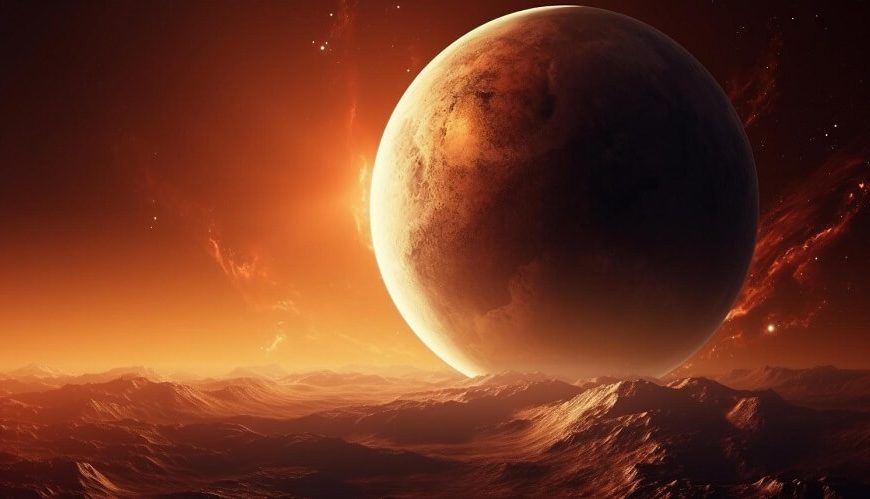Venus is the second planet from the Sun and is the closest planet to Earth other than the Moon. With its distinctive characteristics, this mysterious planet offers a treasure of insightful facts and secrets. It is the most shining planet in the sky and is represented by the letter ♀. This new blog post will provide you with some amazing facts about this intriguing planet, covering its colour, rotation, temperature, size, mesmerising surface characteristics and some frequently asked questions about Venus.
Fascinating Facts About Venus:
- Dry Surface: Venus is extremely dry, with no surface water. Due to high temperatures, there is no liquid water on its surface, but there are small amounts of water vapour within the atmosphere.
- Longest Day and Night: Surprisingly, A day on Venus (the time it takes to rotate once on its axis) is longer than its year. It takes about 243 Earth days to complete one rotation. However, Venus’s year (orbit around the sun) is only about 225 Earth days.
- No Magnetic Field: In contrast to Earth, Venus lacks a global magnetic field. This makes it more vulnerable to the solar wind, which over time may take away its atmosphere.
- Volcanic Plains: Venus has immense plains covered in volcanic lava. This lava is evidence of volcanic history.
- Space Missions to Venus: Several missions have been sent to Venus to explore its atmosphere and surface, including the Venera” program of the Soviet Union and “The Magellan” spacecraft of NASA.
The Color of Venus
The colour of Venus is light yellowish. It is often described as the “Evening Star” or the “Morning Star” due to its impressive appearance. It does not possess the calm blue hues just like our mother Earth. This distinct colour is because of its thick carbon dioxide atmosphere, and sulphuric acid clouds which spread sunlight and give its unique appearance.
Fire-Like Temperature
The climate on Venus is brutal and merciless. The dense atmosphere of the planet traps heat, resulting in burning surface temperatures. Venus is the hottest planet in our solar system, with surface temperatures that reach a scorching 900° degrees Fahrenheit (475° degrees Celsius). It has a type of environment where lead melts like butter!
A Closer Look at Size
Venus has a diameter of around 7,520 miles (12,104 kilometres). Size characteristics are the only aspect that Earth and Venus have in common and have continuously captured the interest of scientists and astronomers. Its diameter is approximately 95% of Earth. While the sizes are similar, their climates are drastically different. The study of these differences between Earth and Venus by various space agencies presents valuable insights into the diverse characteristics of our solar system.
Volcanic Surface
Venus is like a scorching hot oven. It is covered in midst clouds made of sulfuric acid. It is like carrying a big blanket of clouds surrounding everything. The interesting part is that it has lots of volcanoes and these volcanoes are monumental and super-duper hot! They can shoot out lava and gases, making the surface even more hostile.
Enlight the Mysteries with Eurokids
Although Venus has been the subject of numerous engaging discoveries, there is still much to learn about this mysterious planet. With the help of space missions such as “The Venera” program and “The Magellan” many scientists and researchers continue carrying out their research. By exploring Venus, we can gain valuable insights into the mysteries of space science and, perhaps, the possibility of life beyond Earth.
With the expansion of technology, we are getting closer to uncovering the mysteries of thrilling celestial bodies present in our vast solar system. If you want your kids to learn more about these interesting aspects, EuroKids is their launchpad. Here, students are encouraged to have a love for science in a holistic environment. It also stimulates the next generation to reach for the stars and explore the wonders of science. Visit us today, and prepare your child for a bright future ahead.
Frequently Asked Questions
Q1. Is Venus visible to us with the naked eye from Earth?
Ans: Yes, Venus is often visible to us with the naked eye and is one of the brightest entities in the sky.
Q2. Can humans live on Venus?
Ans: Unfortunately, because of the extreme temperature human habitation is not possible.
Q3. How did Venus get its name?
Ans: Venus is named after the Roman goddess of love and beauty.
Q4. Is there water on Venus?
Ans: While there is evidence of water vapour in the atmosphere, its surface is intensely dry.
Q5. Are there any missions intended to explore Venus?
Ans: Yes, several space agencies have sent missions to Venus to study its atmosphere and geology in more detail. “The Venera” program of the Soviet Union and “The Magellan” spacecraft of NASA are some of the missions intended to explore Venus.
Q6. How is the rotation of the planet Venus?
Ans: One of the most terrific aspects of Venus is its slow and reverse rotation. It spins extremely slowly – only once every 243 Earth days.
Q7. Why is Venus known as the hottest planet that makes it different from Earth in one aspect?
Ans.: Due to the thickness of the atmosphere and its composition of greenhouse gases Venus is the hottest planet in the solar system whereas Earth has water vapour which serves as a natural coolant.
Q8. How many moons does Venus have?
Ans. No moon, Yes, Venus is one of only two planets in our solar system without its own moons or satellites.
Q9. How thick is the atmosphere of Venus?
Ans. Venus has an incredibly thick atmosphere with a pressure nearly 92 times greater than Earth’s, primarily composed of carbon dioxide.
Q10. What makes Venus unique?
Ans. Venus is one of the unique planets in our solar system because of its adverse climate. The surface temperature of Venus can rise up to 900 degrees Fahrenheit (475 degrees Celsius) due to the uncontrolled greenhouse effect. And that is insane!















